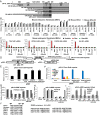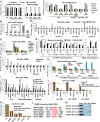GR SUMOylation and formation of an SUMO-SMRT/NCoR1-HDAC3 repressing complex is mandatory for GC-induced IR nGRE-mediated transrepression
- PMID: 26712002
- PMCID: PMC4747746
- DOI: 10.1073/pnas.1522821113
GR SUMOylation and formation of an SUMO-SMRT/NCoR1-HDAC3 repressing complex is mandatory for GC-induced IR nGRE-mediated transrepression
Abstract
Unique among the nuclear receptor superfamily, the glucocorticoid (GC) receptor (GR) can exert three distinct transcriptional regulatory functions on binding of a single natural (cortisol in human and corticosterone in mice) and synthetic [e.g., dexamethasone (Dex)] hormone. The molecular mechanisms underlying GC-induced positive GC response element [(+)GRE]-mediated activation of transcription are partially understood. In contrast, these mechanisms remain elusive for GC-induced evolutionary conserved inverted repeated negative GC response element (IR nGRE)-mediated direct transrepression and for tethered indirect transrepression that is mediated by DNA-bound NF-κB/activator protein 1 (AP1)/STAT3 activators and instrumental in GC-induced anti-inflammatory activity. We demonstrate here that SUMOylation of lysine K293 (mouse K310) located within an evolutionary conserved sequence in the human GR N-terminal domain allows the formation of a GR-small ubiquitin-related modifiers (SUMOs)-NCoR1/SMRT-HDAC3 repressing complex mandatory for GC-induced IR nGRE-mediated direct repression in vitro, but does not affect transactivation. Importantly, these results were validated in vivo: in K310R mutant mice and in mice ablated selectively for nuclear receptor corepressor 1 (NCoR1)/silencing mediator for retinoid or thyroid-hormone receptors (SMRT) corepressors in skin keratinocytes, Dex-induced direct repression and the formation of repressing complexes on IR nGREs were impaired, whereas transactivation was unaffected. In mice selectively ablated for histone deacetylase 3 (HDAC3) in skin keratinocytes, GC-induced direct repression, but not bindings of GR and of corepressors NCoR1/SMRT, was abolished, indicating that HDAC3 is instrumental in IR nGRE-mediated repression. Moreover, we demonstrate that the binding of HDAC3 to IR nGREs in vivo is mediated through interaction with SMRT/NCoR1. We also show that the GR ligand binding domain (LBD) is not required for SMRT-mediated repression, which can be mediated by a LBD-truncated GR, whereas it is mandatory for NCoR1-mediated repression through an interaction with K579 in the LBD.
Keywords: GC-induced direct transrepression; IR nGRE; SUMOylation; glucocorticoid receptor.
Conflict of interest statement
The authors declare no conflict of interest.
Figures











Comment in
-
A trilogy of glucocorticoid receptor actions.Proc Natl Acad Sci U S A. 2016 Feb 2;113(5):1115-7. doi: 10.1073/pnas.1524215113. Epub 2016 Jan 20. Proc Natl Acad Sci U S A. 2016. PMID: 26792523 Free PMC article. No abstract available.
Similar articles
-
Glucocorticoid-induced tethered transrepression requires SUMOylation of GR and formation of a SUMO-SMRT/NCoR1-HDAC3 repressing complex.Proc Natl Acad Sci U S A. 2016 Feb 2;113(5):E635-43. doi: 10.1073/pnas.1522826113. Epub 2015 Dec 28. Proc Natl Acad Sci U S A. 2016. PMID: 26712006 Free PMC article.
-
Glucocorticoid receptor (GR)-associated SMRT binding to C/EBPbeta TAD and Nrf2 Neh4/5: role of SMRT recruited to GR in GSTA2 gene repression.Mol Cell Biol. 2005 May;25(10):4150-65. doi: 10.1128/MCB.25.10.4150-4165.2005. Mol Cell Biol. 2005. PMID: 15870285 Free PMC article.
-
Glucocorticoid Receptor:MegaTrans Switching Mediates the Repression of an ERα-Regulated Transcriptional Program.Mol Cell. 2017 May 4;66(3):321-331.e6. doi: 10.1016/j.molcel.2017.03.019. Mol Cell. 2017. PMID: 28475868 Free PMC article.
-
How glucocorticoid receptors modulate the activity of other transcription factors: a scope beyond tethering.Mol Cell Endocrinol. 2013 Nov 5;380(1-2):41-54. doi: 10.1016/j.mce.2012.12.014. Epub 2012 Dec 23. Mol Cell Endocrinol. 2013. PMID: 23267834 Review.
-
Emerging roles of the corepressors NCoR1 and SMRT in homeostasis.Genes Dev. 2013 Apr 15;27(8):819-35. doi: 10.1101/gad.214023.113. Genes Dev. 2013. PMID: 23630073 Free PMC article. Review.
Cited by
-
Glucocorticoid and Mineralocorticoid Receptors in the Brain: A Transcriptional Perspective.J Endocr Soc. 2019 Jul 24;3(10):1917-1930. doi: 10.1210/js.2019-00158. eCollection 2019 Oct 1. J Endocr Soc. 2019. PMID: 31598572 Free PMC article. Review.
-
Acquired Glucocorticoid Resistance Due to Homologous Glucocorticoid Receptor Downregulation: A Modern Look at an Age-Old Problem.Cells. 2021 Sep 24;10(10):2529. doi: 10.3390/cells10102529. Cells. 2021. PMID: 34685511 Free PMC article. Review.
-
LSD1 inhibition circumvents glucocorticoid-induced muscle wasting of male mice.Nat Commun. 2024 Apr 26;15(1):3563. doi: 10.1038/s41467-024-47846-9. Nat Commun. 2024. PMID: 38670969 Free PMC article.
-
Impact of downstream effects of glucocorticoid receptor dysfunction on organ function in critical illness-associated systemic inflammation.Intensive Care Med Exp. 2020 Dec 18;8(Suppl 1):37. doi: 10.1186/s40635-020-00325-z. Intensive Care Med Exp. 2020. PMID: 33336296 Free PMC article. Review.
-
Glucocorticoid receptor epigenetic activity in the heart.Epigenetics. 2025 Dec;20(1):2468113. doi: 10.1080/15592294.2025.2468113. Epub 2025 Feb 25. Epigenetics. 2025. PMID: 40007064 Free PMC article. Review.
References
-
- Clark AR, Belvisi MG. Maps and legends: The quest for dissociated ligands of the glucocorticoid receptor. Pharmacol Ther. 2012;134(1):54–67. - PubMed
-
- Ratman D, et al. How glucocorticoid receptors modulate the activity of other transcription factors: A scope beyond tethering. Mol Cell Endocrinol. 2013;380(1-2):41–54. - PubMed
-
- Vayssière BM, et al. Synthetic glucocorticoids that dissociate transactivation and AP-1 transrepression exhibit antiinflammatory activity in vivo. Mol Endocrinol. 1997;11(9):1245–1255. - PubMed
Publication types
MeSH terms
Substances
LinkOut - more resources
Full Text Sources
Other Literature Sources
Medical
Molecular Biology Databases
Research Materials
Miscellaneous

